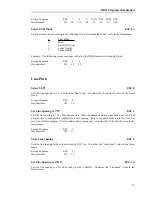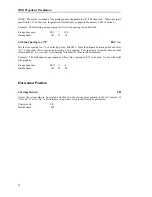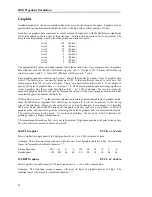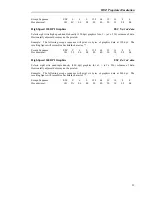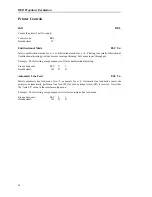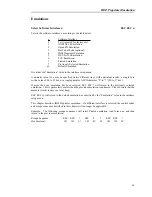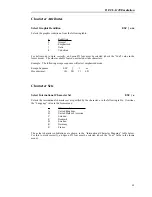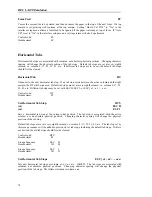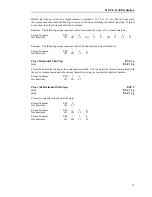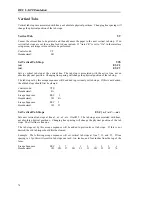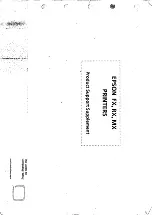
65
DEC LA120 EMULATION
Introduction
This section describes the control codes and escape sequences comprising DEC LA120 emulation.
This emulation may be selected by setting “Emulation” to “LA120” in the interface setup menu, or via
software with the
ESC ESC 5
sequence. While this emulation is selected, control codes and escape
sequences from other emulations are not available.
Control codes and escape sequences are used to control printer operation. An ASCII control code is a
single character in the range 00 hex through 1F hex, and 7F hex. The
ESC
(Escape) control code (1B
hex) is used to introduce character strings called escape sequences, which provide an extension of the
commands available with ASCII control codes.
The LA120 control codes and escape sequences follow the standards of the ANSI X3.64 specification.
Many ANSI escape sequences begin with a two character Control Sequence Introducer (CSI), Escape
Left Square Bracket (
ESC [
, 1B 5B hex). If 8-bit data is selected via control panel setup, these two
characters may be replaced by a single character CSI, 9B hex. The sequences are always documented
in this section with the two character CSI (
ESC [
), because this format seems to be much more
common, and works equally well with 7-bit or 8-bit data.
Some escape sequences accept one or more numeric parameters. A numeric parameter is a decimal
number represented by a string of ASCII decimal digits (“0” through “9”). Leading zeros may be
supplied, but are not necessary. Due to implementation constraints, the largest value that can be
accepted is decimal 255. Larger values will be treated as zero. Omitting a numeric parameter is
equivalent to supplying a value of zero.
If a sequence accepts one numeric parameter, it will be represented as “
n
”. If a sequence accepts more
than one numeric parameter, they will be represented as “
n1
;
n2
; ...
nx
”. Note that multiple numeric
parameters are separated by a semicolon.
Most LA120 escape sequences will assume one of the following formats:
ESC f
(no numeric parameters)
ESC n f
(one numeric parameter)
ESC n1; n2; ... nx f
(two or more numeric parameters)
The “
f
” at the end of the escape sequence represents the final character. It terminates the sequence, and
specifies the function to be performed.
Spaces are used when documenting escape sequences to increase readability. The spaces within the
sequences are for readability only; they are not part of the sequences themselves. Characters that
appear in
italics
(such as “
n
” and “
f
” above) are not sent to the printer as is; they are used as a place
holder indicating that some value must be supplied.
Multiple character strings without intervening spaces typically represent control codes. For example,
BS
is the Backspace control code (08 hex), not the two characters “B” and “S” (42 and 53 hex). An
ASCII Control Code Table is provided on page 139 for your convenience. If you have any doubt
about how to interpret a documented control code or escape sequence, refer to the hex representation in
the provided example. This should clarify any ambiguity. The examples may also be helpful when
analyzing a hex dump (see Hex Dump chapter) printed by the printer.
Summary of Contents for FormsMaster 8000
Page 6: ......
Page 10: ......
Page 24: ......
Page 50: ......
Page 70: ......
Page 89: ...DEC LA120 Emulation 83 VT Vertical Tab VTS Set Vertical Tab Stop...
Page 90: ......
Page 122: ......
Page 124: ......
Page 140: ...ASCII Character Tables 134 Epson FX Fast Draft Epson FX Draft Epson FX Letter Quality...
Page 141: ...ASCII Character Tables 135 PC Fast Draft PC Draft PC Letter Quality...
Page 142: ...ASCII Character Tables 136 EBCDIC Fast Draft EBCDIC Draft EBCDIC Letter Quality...
Page 144: ...ASCII Character Tables 138 OCR A OCR B...
Page 148: ......

